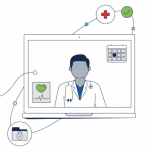In a recent blog, we discussed how healthcare providers are designing and building new smart hospitals using technology as the fourth utility to securely connect clinical, operational, and business systems, applications, devices, users, and data. Once connected, these systems can be programmed to work together to deliver improved workflows and multiple organizational goals, including business resiliency, operational efficiency, security, and improved clinician, patient, and guest experiences.
Healthcare providers are also using the smart hospital, telehealth, and virtual care to reduce energy consumption and CO2 emissions, helping them achieve environmental and sustainability targets.
Healthcare sustainability
At the recent United Nations Climate Change conference, COP26, a group of 50 countries, including the United States, United Kingdom, Germany, and Canada committed to develop climate-resilient and low-carbon health systems. These countries signed on to the World Health Organization’s (WHO) COP26 Health Programme, which seeks a future of healthcare that is resilient to the impacts of climate change, extreme weather events, and increased incidence of diseases related to air pollution and global warming. These countries are committed to reduce the impact their health systems have on CO2 emissions and climate change. The dual objectives of a climate-resilient and low carbon health system were emphasized by an open letter from over 450 healthcare providers representing more than 46 million healthcare workers around the world. This group warned the climate crisis is the single biggest health threat facing humanity and calls on world leaders to deliver on climate action.
Building operations account for as much as 70% of electricity consumption, and approximately 30% of CO2 emissions. Building construction and materials account for another 11% of CO2 emissions.
As an industry, healthcare accounts for 4.4–4.6% of worldwide greenhouse gas emissions. The U.S. healthcare system accounts for almost one quarter of these emissions, a figure which grew by 6% between 2010 and 2018. These emissions contribute to climate change and indirectly lead to reduced health outcomes.
Healthcare providers planning to construct new buildings or retrofit existing ones want their buildings to consume less energy and contribute to national, state, and local carbon reduction targets.
Sustainability and decarbonization with a smart hospital
As systems and devices are connected and secured using the fourth utility, they can be powered with low voltage 90 W universal Power over Ethernet (UPOE+), delivering lower energy consumption and reduced CO2 emissions.
A converged smart building architecture can power multiple building systems and devices, including bedside medical devices, LED lights, motorized window shades, HVAC, building management systems, entry systems, elevators, and alarm systems. As a result, energy consumption can be reduced by up to 45% or more, directly resulting in a reduction of 24 metric tonnes of CO2 emissions (MTCO2e) annually. Additional energy savings and reductions of up to 11 MTCO2e can be achieved through reduced materials used in building construction. In turn, these energy savings and sustainability can be used to obtain LEED and WELL certifications as well as stimulus and energy efficiency grants.
Take LED lighting as an example: As discussed in the recent smart hospital blog, LED lighting can deliver improved patient and clinician experiences and clinical outcomes – using programmability and circadian rhythm lighting. POE LED lighting also contributes significantly to lower operating costs and reduced CO2 emissions – as much as 3-6% reduced energy waste and 8% lower total cost of ownership compared with AC LED (27% lower than AC florescent).
A smart hospital can harness the fourth utility to deliver reduced power consumption and sustainability, improved security, and data-driven clinical workflows.

Telehealth and virtual care: A bridge to improved access to care and sustainability
In 2020, the Centre for Addiction and Mental Health (CAMH), Canada’s largest mental health teaching hospital, increased its delivery of virtual care for mental health visits by nearly 750% in a single month. This shift enabled more flexibility in scheduling appointments and follow-ups, shorter wait times, and greater accessibility by removing barriers to access, particularly for patients in rural and remote locations (including remote Indigenous communities).
In addition to these benefits, telehealth has been shown to result in reduced carbon emissions as a result of fewer car journeys. A recent study published in the Journal of Climate Change and Health found that carbon emissions from patient travel for primary care, specialty care, and mental health visits in Washington and Oregon fell by as much as 46% between 2019 and 2020, as a result of a shift from in-person visits to virtual care. A survey of 14 research reports in the United States, United Kingdom, Canada, Spain, Portugal, and Sweden found that virtual care and telehealth consultations resulted in carbon emissions savings between 0.70–372 kg CO2e per consultation, owing mostly to reduced travel. These studies also showed that telehealth can play a role in climate-related business resiliency, by allowing patient consultations to continue in the wake of extreme weather events.
As patients and clinicians embrace telehealth and virtual care, the improved accessibility, flexibility, and convenience will be accompanied by dramatic reductions in energy costs and carbon emissions.
As we work with healthcare providers and partners to help design and build smart hospitals, telehealth, and virtual care, we see the potential for them to deliver multiple organizational goals while delivering improved energy efficiency, carbon reduction, and sustainability. These outcomes will help healthcare providers meet emissions targets and contribute to the objectives set forth in the COP26 Healthcare Programme.
No matter what sustainability goals your healthcare organization is looking to achieve, Cisco can help build the bridge to get you there.
For more information on smart and sustainable hospitals, please visit the following resources:
- Smart hospitals on Cisco portfolio explorer for healthcare
- Cisco portfolio explorer for smart buildings
- Case study: Smart hospital
- Case study: Smart and intuitive workplace
- Smart buildings infographic: Intelligent workplace
This post was jointly authored by Sean Caragata and Ross Sweetzir.


CONNECT WITH US